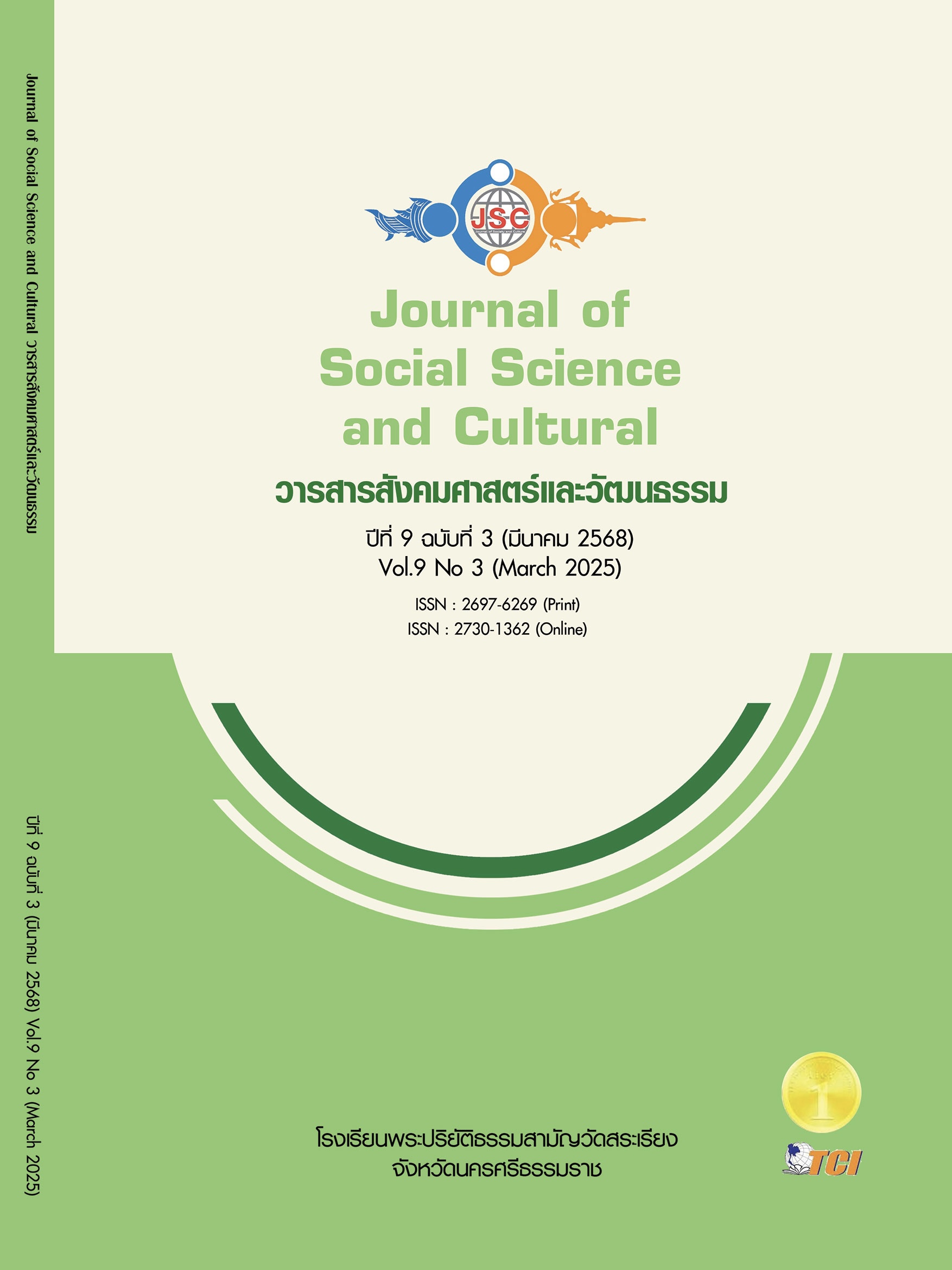A MANAGEMENT GUILDLINE TO REDUCE LABOR CONFLICTS AND DISPUTES FOR BUSINESS ORGANIZATIONS IN CHONBURI INDUSTRIAL ESTATE
Main Article Content
Abstract
Labor disputes among business organizations continue to exist due to ecomomic problems. Finding ways to manage conflicts from labor disputes is therefore important in order to prevent problems that affect the organization in the future. This research aimed 1) To compare the differences in the elements of a management guideline to reduce labor conflicts and disputes in the business organizations classified by business sizes; and 2) To develop a structural equation model of a management guideline to reduce labor conflicts and disputes in the business organizations. Questionnaire was used to collect data from 500 samples of management in Chonburi industrial estate. The data collection was conducted through the 5 pints scale questinnaires. The collected data were thereafter analyzed using structural equation modeling. Resulted showed that anaylis of the data revealed that the newly developed structural equation model corresponded to
the data reporting p-value = .060 , CMIN/DF = 1.151, GFI = .957 และ RMSEA = .017 and p = .05 which confirmed wth the set criteria for the results fo variable analysis. Large business focused on management guideline to reduce labor conflicts and disputes in the business organizations more than SMEs. A management guideline to reduce labor conflicts and disputes in the business organizations were of dimensions arranged in the order of importance as follows: organization support ( = 4.22) the organizations should revise or issue work regulations to conform to economic, benefits (
= 4.21) listen to welfare proposals from employee, conflict management (
= 4.21) at least for once a year, staff meeting is required in order to exchange opinions related to labor problems, and internal organization collaboration (
= 4.15) a committee consisting of representatives from both employer and employee sides should be established to consider on the complaints in case of dissatisfaction from some complainants, until a resolution is reached.
Article Details
References
กรมโรงงานอุตสาหกรรม. (2567). ข้อมูลโรงงานในเขตการนิคมอุตสาหกรรม. เรียกใช้เมื่อ 9 พฤศจิกายน 2567 จาก https://userdb.diw.go.th/factory/ieat.asp
กรมสวัสดิการและคุ้มครองแรงงาน. (2567). สถานการณ์ด้านแรงงานรายปี 2566. เรียกใช้เมื่อ 9 พฤศจิกายน 2567 จาก https://www.mol.go.th/wp-content/uploads/sites/2/2024/04/สถานการณ์แรงงาน-รายปี-2566.pdf
จุฑาทิพย์ สุจริตกุล. (2565). การบริหารความขัดแย้งในองค์กร. วารสารรัชต์ภาคย์, 16(48), 1-16.
เจษฎา นกน้อย. (2567). การจัดการข้อพิพาทแรงงานด้วยแนวทางสมานฉันท์. วารสารการพัฒนาชุมชนและคุณภาพชีวิต, 12(3), 222-234.
ชุติมา นุตยสกุล. (2567). การพัฒนากลยุทธ์การบริหารคนเก่งเพื่อสร้างความได้เปรียบในการแข่งขันของอุตสาหกรรมไฟฟ้าและอิเล็กทรอนิกส์ในจังหวัดฉะเชิงเทรา. วารสารมนุษยศาสตร์และสังคมศาสตร์ มหาวิทยาลัยนครพนม, 14(2), 68-82.
ณฐาพัชร์ วรพงศ์พัชร์ และพิชิต ภาสบุตร. (2565). การบริหารทรัพยากรบุคคลและการจัดการความขัดแย้งในองค์กรของอุตสาหกรรมยานยนต์ในจังหวัดชลบุรี. วารสารการจัดการการเมืองการปกครองและท้องถิ่น, 2(1), 1-14.
ธัญรัศม์ จิรฐิติเกียรติ และณฐนนท ทวีสิน. (2567). ความสัมพันธ์เชิงสาเหตุของแรงจูงใจในการทำงานที่ส่งผลต่อประสิทธิภาพในการปฏิบัติงานของพนักงานในอุตสาหกรรมการผลิตน้ำดื่มประเทศไทย: กรณีศึกษาอิทธิพลคั่นกลางของตัวแปรความผูกพันต่อองค์การ. วารสารเครือข่ายส่งเสริมการวิจัยทางมนุษยศาสตร์และสังคมศาสตร์, 7(2), 26-46.
ประเสริฐศักดิ์ โพธิ์ทอง และทศพล ปรีชาศิลป์. (2567). ความสัมพันธ์เชิงสาเหตุของปัจจัยด้านการทำงานจากที่บ้าน สภาพแวดล้อมในการทำงาน ความพึงพอใจในงานและแรงจูงใจในการทำงานต่อประสิทธิภาพการทำงานของพนักงานหน่วยงานสนับสนุนของธนาคารพาณิชย์ขนาดใหญ่ในประเทศไทย. วิทยาการจัดการวไลยอลงกรณ์ปริทัศน์, 5(2), 1-15.
มนฤทัย อินทร์ทองสุข และณกม จันทร์สม. (2564). เป้าประสงค์ของการสร้างความสัมพันธ์ระหว่างคุณภาพชีวิตในการทำงานกับความผูกพันต่อองค์กรของพนักงานในองค์การ. วารสารวิทยาการจัดการปริทัศน์, 23(2), 235-246.
ลัดดาวัลย์ สำราญ และคณะ. (2566). การสร้างแรงงานสัมพันธ์ที่ดีเพื่อป้องกันและแก้ไขปัญหาข้อพิพาทแรงงาน. วารสาร มจร สังคมศาสตร์ปริทรรศน์, 12(6), 426-442.
วันเพ็ญ วรรณกูล และคณะ. (2564). ปัจจัยที่มีผลต่อการส่งเสริมแรงงานสัมพันธ์ที่ดีในโรงงานอุตสาหกรรมบริษัทผลิตและจำหน่ายขนมอบกรอบแห่งหนึ่ง ในนิคมอมตะนคร จังหวัดชลบุรี. วารสารวิชาการสังคมศาสตร์เครือข่ายวิจัยประชาชื่น, 3(1), 24-44.
สมเจตน์ ภิรมย์มาก และคณะ. (2563). รูปแบบนโยบายภาครัฐในการสร้างความมั่นคงของแรงงานไทยในภาคอุตสาหกรรม. วารสารการเมือง การบริหาร และกฎหมาย, (12)1, 139-156.
สำนักงานศาลยุติธรรม. (2567). หนังสือรายงานสถิติคดีของศาลทั่วราชอาณาจักร ประจำปี พ.ศ. 2566. เรียกใช้เมื่อ 9 พฤศจิกายน 2567 จาก https://oppb.coj.go.th/th/content/category/detail/id/22/iid/446976
สำนักแรงงานสัมพันธ์. (2567). แรงงานสัมพันธ์เชิงบริหาร: เส้นทางการอยู่ร่วมกันของนายจ้างลูกจ้าง. เรียกใช้เมื่อ 10 พฤศจิกายน 2567 จาก https://relation.labour.go.th/2017-09-01-06-47-59/157-2017-09-07-04-49-49
Alhassami, S. & Bhaumik, A. (2019). The mediantion effect of group innovative performance on the relationship between conflict management strategies and project conflict manifestations within engineering and IT firms in the UAE. International Journal of Innovation Technology and Exploring Engineering, 8(8), 439-445.
Arbuckle, J. L. (2016). IBM SPSS Amos 20 user's guide. New York: IBM.
Balwant, P. et al. (2020). Transformational leadership and employee engagement in Trinidad's service sector. International Journal of Emerging Markets, 15(4), 691-715.
Cronbach, L. J. (1951). Coefficient alpha and the internal structure of tests. Psychometrika Journal, 16(3), 297-334.
Hair, J. F. et al. (2021). Partial least squares structural equation modeling (PLS-SEM) using R. Switzerland: Springer Nature Switzerland AG.
Ridwan, M. et al. (2020). Improving employee performance through perceived organization support, organizational commitment and organizational citizenship behavior. Systematic Reviews in Pharmacy, 11(12), 839-849.
Robbins, S. & Judge, T. (2024). Organizational behavior. (19rd ed.). New Jersey: Pearson Education Inc.
Rovinelli, R. J. (1976). Methods for Validating Criterion-Referenced Test Items. Unpublished Doctoral Dissertation. University of Massachusetts Amherst. Retrieved September 5, 2022, from https://core.ac.uk/reader/32441550
Thitiya, M. & Sakrapee, W. (2020). Guidelines to retain staffs in industrial business organization. Academy of Entrepreneurship Journal, 26(1), 1-11.


